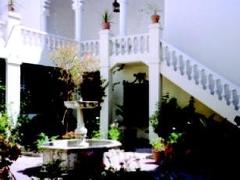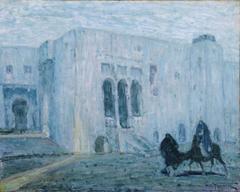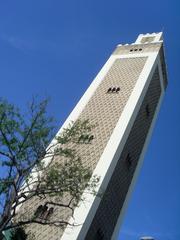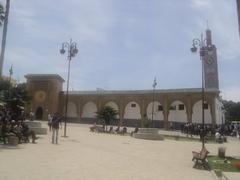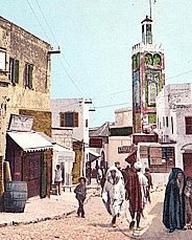
Tangier Bullring: Visiting Hours, Tickets, and Historical Significance Guide
Date: 04/07/2025
Introduction
The Tangier Bullring, locally known as Plaza de Toros or Place des Arènes, is an iconic emblem of Tangier’s rich, multicultural heritage. Erected in the 1940s by the Spanish expatriate community during Tangier’s international zone era, it was inaugurated in 1950 with a seating capacity for over 13,000 spectators. Its design masterfully blends mid-20th-century Spanish civic architecture with Moorish influences, symbolizing Tangier’s historical ties between Africa and Europe. Initially conceived for hosting Spanish bullfighting events, the bullring’s significance has since evolved—serving as a cultural and artistic hub before falling into disuse in the 1970s.
Recognizing its historical value, Moroccan authorities declared the Plaza de Toros a national monument in 2016, sparking a major restoration that began in 2021. This ambitious project preserves the arena’s architectural integrity while transforming it into a vibrant cultural venue with open-air theaters, exhibition spaces, commercial venues, and leisure facilities. Today, the Tangier Bullring stands as a testament to the city’s layered history and ongoing cultural renaissance, making it an essential stop for visitors interested in architecture, urban history, and contemporary Moroccan culture (Wikipedia; Morocco World News; en.bladi.net).
Table of Contents
- Introduction
- History and Construction
- Architectural Features
- Restoration and Contemporary Role
- Visiting Information
- Travel Tips
- Nearby Attractions
- Cultural Etiquette
- FAQ
- Conclusion
- Sources
History and Construction
Origins
The Tangier Bullring was constructed by the Spanish community between the late 1940s and 1950. Designed by Spanish architect Francisco Rodriguez-Alvarez Lopez, the project was completed in just fourteen months. Officially inaugurated on August 27, 1950, its 13,013-seat arena reflected the tastes and traditions of Tangier’s then-flourishing Spanish expatriate population (Wikipedia; Morocco World News).
Cultural Significance
Between 1950 and 1956, the bullring was a centerpiece for traditional Spanish bullfighting, attracting audiences from across Tangier’s diverse communities. After Moroccan independence in 1956, its use shifted toward artistic and cultural performances before entering a period of abandonment around 1970. Despite this, the bullring remains a powerful symbol of Tangier’s multicultural identity, bridging Spanish and Moroccan heritage (en.bladi.net).
Architectural Features
Design and Layout
The bullring’s architecture exemplifies mid-20th-century Spanish civic style, with pronounced Moorish accents in its arches and stucco façade. The circular structure and tiered seating ensure optimal visibility, while radial symmetry and robust masonry highlight both aesthetic and practical considerations (Morocco World News).
Restoration and Adaptive Reuse
A major restoration project commenced in 2021, guided by principles of architectural conservation. The renovation not only reinforces the original structure but introduces modern amenities, accessibility features, and sustainable materials. The bullring’s transformation into a multi-purpose cultural center includes an open-air theater, exhibition halls, commercial spaces, and community facilities (Morocco World News).
Restoration and Contemporary Role
Heritage Recognition
In 2016, the bullring received national monument status, underscoring its historical and cultural importance (en.walaw.press). The ongoing restoration, completed in 2025, aligns with Tangier’s broader strategy to revitalize its cultural infrastructure, boost tourism, and celebrate its cosmopolitan legacy.
New Functions
Today, the renovated arena hosts a range of cultural events—concerts, exhibitions, festivals, and community gatherings—while preserving its architectural identity. The open-air theater accommodates up to 7,000 spectators, and new exhibition and commercial spaces foster year-round activity (Morocco World News).
Visiting Information
Hours and Tickets
- Opening Hours: Tuesday to Sunday, 10:00 AM–6:00 PM; closed Mondays and public holidays.
- Tickets: General admission is MAD 50 (~$5), with discounts for students, seniors, and groups. Entry to exterior areas may be free; tickets are required for special events and exhibitions. Purchase tickets online or at the venue.
Accessibility
The bullring now features ramps, elevators, and dedicated seating, making it fully accessible for visitors with disabilities.
Transportation and Parking
Located on Avenue Yacoub El Mansour, the bullring is easily reached by taxi or public transport from Tangier’s city center. Limited parking is available nearby, with additional spaces in adjacent lots.
COVID-19 Guidelines
Visitors should follow current health protocols, including mask usage and social distancing indoors. Check the official Tangier tourism website for updated guidelines.
Travel Tips
- Best Time to Visit: Weekday mornings are quieter; check the event calendar for cultural performances.
- Guided Tours: Daily tours at 11:00 AM and 3:00 PM in Arabic, French, and English; advance booking recommended.
- Photography: The rooftop terrace offers panoramic city views; always respect signage and staff regarding photography policies.
- Footwear: Wear sturdy shoes for exploring historic surfaces.
- Hydration: Bring water and sun protection, especially in summer.
Nearby Attractions
- Kasbah Museum: Showcasing Moroccan art and history.
- Grand Socco: Bustling square with markets and cafés.
- Caves of Hercules: Natural site with dramatic coastal views.
- American Legation Museum: Celebrating Tangier’s international heritage.
Cultural Etiquette
- Dress Modestly: Cover shoulders and knees, especially in non-tourist areas (moroccowanderer.com).
- Politeness: Greet locals with “As-salamu alaykum” and respond courteously to offers.
- Photography: Always ask before photographing people; respect refusals.
- Language: Arabic and French are widely spoken; Spanish is common near the bullring, English is understood in tourist hubs.
Frequently Asked Questions (FAQ)
Q: What are the visiting hours of the Tangier Bullring?
A: Tuesday–Sunday, 10:00 AM–6:00 PM; closed Mondays and public holidays.
Q: How can I buy tickets?
A: Online via the official website or on-site at the venue.
Q: Is the bullring accessible for people with disabilities?
A: Yes, with ramps, elevators, and accessible seating.
Q: Are guided tours offered?
A: Yes, daily at 11:00 AM and 3:00 PM in several languages.
Q: Is the bullring safe to visit?
A: Tangier is generally safe, but take standard precautions and avoid isolated areas after dark (mustvisitmorocco.com).
Visual and Interactive Media
- For a richer visit, explore high-quality images of the bullring’s architecture: look for photos with alt text like “Tangier Bullring exterior with Moorish arches.”
- The official website and visitor center offer virtual tours and interactive maps.
- Videos documenting the restoration and cultural events are available online.
Conclusion
The Tangier Bullring stands as a living testament to the city’s unique blend of history, architecture, and culture. Its meticulous restoration and adaptive reuse highlight Tangier’s commitment to honoring its past while fostering a dynamic cultural future. Whether you are drawn by its architectural grandeur, historical narrative, or vibrant contemporary programming, the bullring offers a memorable, enriching experience for every visitor.
Download the Audiala app for updates on events and tickets at the Tangier Bullring and explore our guides to Tangier’s other cultural gems. Plan your visit today and immerse yourself in the captivating story of Tangier’s Plaza de Toros.
Sources and Official Links
- Wikipedia: Plaza de Toros Tangier
- Morocco World News: Tangier’s Historic Bullfighter Arena
- Tangier to Restore Historic Spanish Bullring
- Tangier Bullring Classified as Monument
- Tangier History and Travel Tips - Kaikaikaki.com
- Living Tours: Main Tourist Attractions in Tangier
- GoWithGuide: Tourism in Tangier Statistics
- WizTour: Tangier’s Rich History & Cultural Heritage
- Life in the Fast Jane: Tangier Travel Guide
- Must Visit Morocco: Is Tangier Safe?
- Morocco Wanderer: Moroccan Etiquette
- Trafalgar: Moroccan Culture & Etiquette
- Tangier Excursions: Morocco Travel Tips

